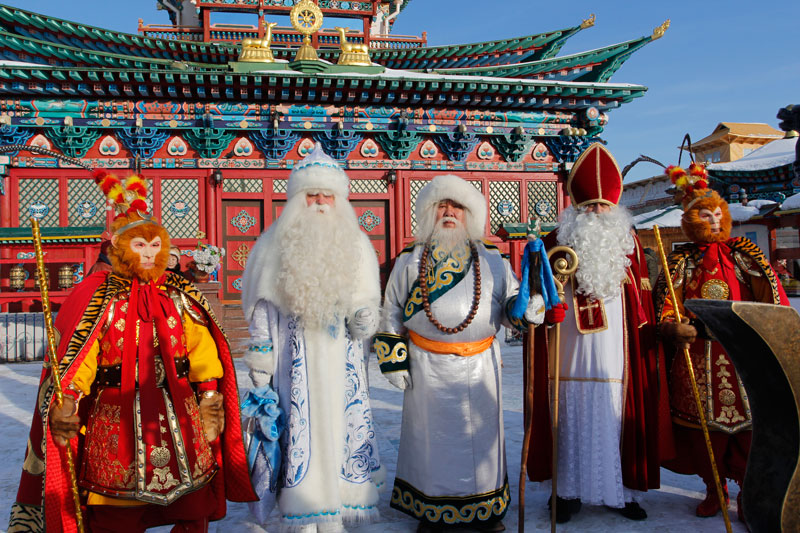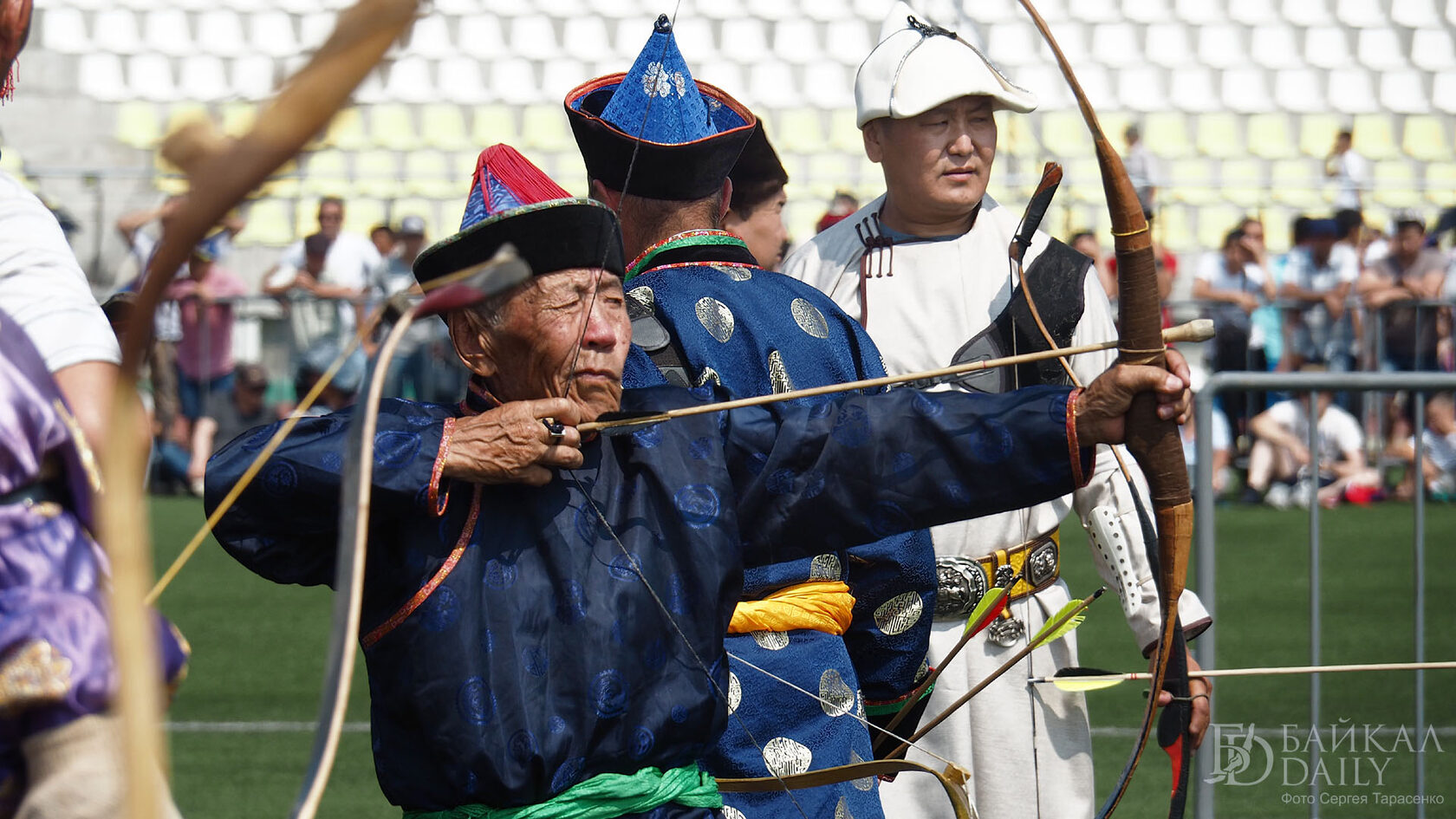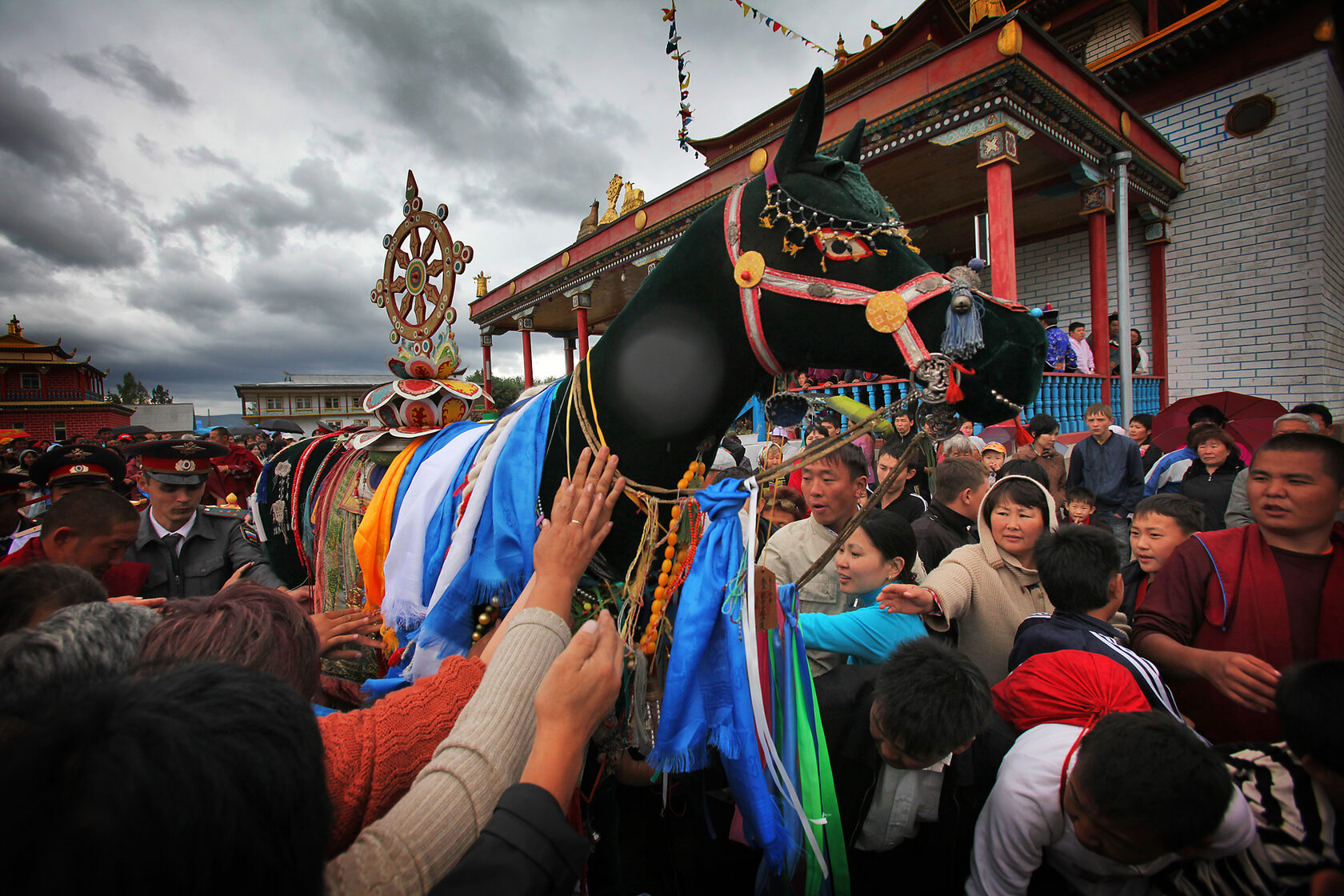Ulan-Ude is an amazing city in Russia, where there are twice as many holidays as in other cities of the country. Here they celebrate both the New Year, Christmas, Maslenitsa and Easter, which are familiar to Russians, as well as holidays associated with the lunar calendar and Buddhist traditions. Read about what holidays the Ulan-Ude people celebrate on a grand scale.

Sagaalgan
The main holiday of all Buddhistsn in winter is Sagaalgan, or the holiday of the White Month. The date of the new year is not fixed in the lunar calendar; it is calculated every year using astrological tables. And every year finds itself under protection of one of the twelve animals granted a year of reign by Buddha. According to legend, before leaving the earth, Buddha called all the animals to him, but only 12 of them responded to his call to say goodbye: Rat, Ox, Tiger, Hare, Dragon, Snake, Horse, Sheep, Monkey, Rooster, Dog, and Pig. It is believed that they all bring personal character traits to their year. So, the patron of 2023 was the Black Water Rabbit, in 2024 the Green Wood Dragon will take its place, and so on.
White Month was once celebrated in autumn and was considered a holiday of dairy products. Later, the Mongol Kublai Khan, the grandson of Genghis Khan, moved it to the end of winter, influenced by the Chinese astrology. And over time, the meaning of the White Month has ceased to be associated only with milk — now it symbolizes the renewal of man and nature, hope for happiness and prosperity, cleansing from all bad things. For residents of Buryatia, the first day of the White Month is officially declared the non-working day, and the entire subsequent month is accompanied by folk festivals, concerts and home celebrations.
Preparation for the holiday begins long before it starts. People are cleaning their houses, trying to finish things they started, pay off debts, and get rid of unnecessary things. Two days before Sagaalgan, a purification ritual, Dugzhuuba, is held in the Buddhist temples /link to the “Temples, datsans and shrines of Ulan-Ude” article/. At this time, believers burn small pieces of dough, in which they mentally wrap everything bad, in a large ritual fire. The next day is considered “closed”; it should be spent at home with loved ones, praying and doing only good deeds.
On the first day of the White Month, the Palden Lhamo deity enters every home. It counts the inhabitants of the house and brings happiness to everyone. On this day it is customary to get up very early so as not to oversleep the luck for the next year. After awakening, household members pray, make offerings to the gods and go to a solemn prayer service.
During the White Month, it is considered obligatory to visit people. You need to have time to visit all your relatives, starting with older relatives and parents, and present gifts. The greeting is special at this time: the younger one extends his hands with palms up to the older one, and the latter, in response, places his hands on top of them with palms down. This gesture conveys respect and a promise of help and support.
The festive table is also usually prepared in advance. A favorite family pastime is preparing a traditional Buryat dish — buuz . The minced meat is wrapped in dough and frozen so that they are ready for the arrival of guests — it only remains to cook the required portion of buuz. Not forgetting the roots of the holiday, the house keepers put “white”, dairy food on the table — salamata made from sour cream and flour, dry Ayrkhan cottage cheese, and dried homemade Khuruud cheese.
The main holiday of all Buddhistsn in winter is Sagaalgan, or the holiday of the White Month. The date of the new year is not fixed in the lunar calendar; it is calculated every year using astrological tables. And every year finds itself under protection of one of the twelve animals granted a year of reign by Buddha. According to legend, before leaving the earth, Buddha called all the animals to him, but only 12 of them responded to his call to say goodbye: Rat, Ox, Tiger, Hare, Dragon, Snake, Horse, Sheep, Monkey, Rooster, Dog, and Pig. It is believed that they all bring personal character traits to their year. So, the patron of 2023 was the Black Water Rabbit, in 2024 the Green Wood Dragon will take its place, and so on.
White Month was once celebrated in autumn and was considered a holiday of dairy products. Later, the Mongol Kublai Khan, the grandson of Genghis Khan, moved it to the end of winter, influenced by the Chinese astrology. And over time, the meaning of the White Month has ceased to be associated only with milk — now it symbolizes the renewal of man and nature, hope for happiness and prosperity, cleansing from all bad things. For residents of Buryatia, the first day of the White Month is officially declared the non-working day, and the entire subsequent month is accompanied by folk festivals, concerts and home celebrations.
Preparation for the holiday begins long before it starts. People are cleaning their houses, trying to finish things they started, pay off debts, and get rid of unnecessary things. Two days before Sagaalgan, a purification ritual, Dugzhuuba, is held in the Buddhist temples /link to the “Temples, datsans and shrines of Ulan-Ude” article/. At this time, believers burn small pieces of dough, in which they mentally wrap everything bad, in a large ritual fire. The next day is considered “closed”; it should be spent at home with loved ones, praying and doing only good deeds.
On the first day of the White Month, the Palden Lhamo deity enters every home. It counts the inhabitants of the house and brings happiness to everyone. On this day it is customary to get up very early so as not to oversleep the luck for the next year. After awakening, household members pray, make offerings to the gods and go to a solemn prayer service.
During the White Month, it is considered obligatory to visit people. You need to have time to visit all your relatives, starting with older relatives and parents, and present gifts. The greeting is special at this time: the younger one extends his hands with palms up to the older one, and the latter, in response, places his hands on top of them with palms down. This gesture conveys respect and a promise of help and support.
The festive table is also usually prepared in advance. A favorite family pastime is preparing a traditional Buryat dish — buuz . The minced meat is wrapped in dough and frozen so that they are ready for the arrival of guests — it only remains to cook the required portion of buuz. Not forgetting the roots of the holiday, the house keepers put “white”, dairy food on the table — salamata made from sour cream and flour, dry Ayrkhan cottage cheese, and dried homemade Khuruud cheese.

Surkharbaan and Altargana
The sports folk festival Surkharbaan is another great day for Ulan-Ude. Traditionally it is held on the first Sunday of July. Previously, the holiday was called "Three Games of Husbands" ("Eryn gurban naadan"). Now its name is translated from Buryat as "Shooting on suras" — a leather target. In addition to archery, the games include Buryat "Behe barildaan" wrestling, horse racing and sometimes spinal bone breaking competitions. Surkharbaan is always celebrated accompanied by a spectacular concert program with songs and Yohor, master classes on embossing, fabric painting and drawing in ethnic style. The competitions take place at the Central Stadium and the Ivolginsky Datsan Hippodrome.
Altargana, a holiday for Buryats all over the world, is also held in the summer. But you can’t always catch it in Ulan-Ude — it takes place every two years and each time is transferred from region to region: the holiday was held in the Irkutsk region and Transbaikal, in different cities of Mongolia and, certainly, in the capital of Buryatia. Altargana is a small shrub with small leaves and flowers, famous for its powerful root system. It has become a symbol of love and affection for the homeland of all the Buryats who find themselves cut off from their roots.
Now the holiday consists of several parts: these are song competitions for soloists and folklore groups, sports competitions in archery, horse racing and wrestling, competitions for masters of decorative and applied arts and the best uligershin storytellers. Participants compete in spinal bone breaking (heer shaalgan), playing Buryat chess (shatar) and dice (shagai naadan).
The sports folk festival Surkharbaan is another great day for Ulan-Ude. Traditionally it is held on the first Sunday of July. Previously, the holiday was called "Three Games of Husbands" ("Eryn gurban naadan"). Now its name is translated from Buryat as "Shooting on suras" — a leather target. In addition to archery, the games include Buryat "Behe barildaan" wrestling, horse racing and sometimes spinal bone breaking competitions. Surkharbaan is always celebrated accompanied by a spectacular concert program with songs and Yohor, master classes on embossing, fabric painting and drawing in ethnic style. The competitions take place at the Central Stadium and the Ivolginsky Datsan Hippodrome.
Altargana, a holiday for Buryats all over the world, is also held in the summer. But you can’t always catch it in Ulan-Ude — it takes place every two years and each time is transferred from region to region: the holiday was held in the Irkutsk region and Transbaikal, in different cities of Mongolia and, certainly, in the capital of Buryatia. Altargana is a small shrub with small leaves and flowers, famous for its powerful root system. It has become a symbol of love and affection for the homeland of all the Buryats who find themselves cut off from their roots.
Now the holiday consists of several parts: these are song competitions for soloists and folklore groups, sports competitions in archery, horse racing and wrestling, competitions for masters of decorative and applied arts and the best uligershin storytellers. Participants compete in spinal bone breaking (heer shaalgan), playing Buryat chess (shatar) and dice (shagai naadan).

Buddhist holidays
Holidays associated with the teachings of Buddha enjoy special esteem in Ulan-Ude. All of them, like Sagaalgan, do not have a strictly fixed date. In May and June, Donchod Khural, or the “Feast of a Thousand Offerings,” is celebrated, dedicated to the birth, enlightenment, and parinirvana of Buddha Shakyamuni. In December, Zula Khural takes place — the festival of offering a thousand heavenly lamps, which is dedicated to the day of passing of the Great Teacher Tsonghava into nirvana.
One of the most solemn Buddhist holidays is Maidari Khural, or the Circle of Maidari (Maitreya) — the Buddha of the future global order. This is what Buddhism calls the time that will come after the period of "ruling our world by Buddha Shakyamuni" ends.
Maidari Khural is celebrated in June-July and begins with a festive prayer service in datsans. Then the lamas, accompanied by believers, make a goroo (detour) around the monastery with a sculpture of the Buddha Maitreya, which is mounted on a chariot harnessed to a green horse or a white elephant. They are followed by monks who beat drums and chant prayers.
Part of the ritual may include the painstaking creation of a mandala by monks from painted sand, as well as a fascinating tradition — the Mystery Tsam. This is a dance performed by monks dressed in costumes and masks of Buddhist deity characters. In Buryatia, the White Elder, the patron saint of the White Month, appears with them. The dance can last for several hours, helps rid the area of problems and diseases, and gives wisdom and knowledge to spectators and participants.
In winter, Ulan-Ude is decorated with New Year's lanterns and garlands, there is a richly decorated Christmas tree on the Soviet Square, in the parks you can go ice skating and slide down a steep slide, and conversations often begin with the phrase "Shene zheleer", which means "Happy New Year" in Buryat. On Maslenitsa, townspeople go to say goodbye to winter and eat pancakes at the Ethnographic Museum. On Easter, believers go to churches, and everyone else paints eggs different colors and plays the "Who is stronger?" game. In a short summer, Ulan-Ude residents have time to enjoy the music festivals "Night of Yohor" and "Voice of the Nomads" in order to warm themselves in autumn with warm memories of the bright holidays of the year.
Holidays associated with the teachings of Buddha enjoy special esteem in Ulan-Ude. All of them, like Sagaalgan, do not have a strictly fixed date. In May and June, Donchod Khural, or the “Feast of a Thousand Offerings,” is celebrated, dedicated to the birth, enlightenment, and parinirvana of Buddha Shakyamuni. In December, Zula Khural takes place — the festival of offering a thousand heavenly lamps, which is dedicated to the day of passing of the Great Teacher Tsonghava into nirvana.
One of the most solemn Buddhist holidays is Maidari Khural, or the Circle of Maidari (Maitreya) — the Buddha of the future global order. This is what Buddhism calls the time that will come after the period of "ruling our world by Buddha Shakyamuni" ends.
Maidari Khural is celebrated in June-July and begins with a festive prayer service in datsans. Then the lamas, accompanied by believers, make a goroo (detour) around the monastery with a sculpture of the Buddha Maitreya, which is mounted on a chariot harnessed to a green horse or a white elephant. They are followed by monks who beat drums and chant prayers.
Part of the ritual may include the painstaking creation of a mandala by monks from painted sand, as well as a fascinating tradition — the Mystery Tsam. This is a dance performed by monks dressed in costumes and masks of Buddhist deity characters. In Buryatia, the White Elder, the patron saint of the White Month, appears with them. The dance can last for several hours, helps rid the area of problems and diseases, and gives wisdom and knowledge to spectators and participants.
In winter, Ulan-Ude is decorated with New Year's lanterns and garlands, there is a richly decorated Christmas tree on the Soviet Square, in the parks you can go ice skating and slide down a steep slide, and conversations often begin with the phrase "Shene zheleer", which means "Happy New Year" in Buryat. On Maslenitsa, townspeople go to say goodbye to winter and eat pancakes at the Ethnographic Museum. On Easter, believers go to churches, and everyone else paints eggs different colors and plays the "Who is stronger?" game. In a short summer, Ulan-Ude residents have time to enjoy the music festivals "Night of Yohor" and "Voice of the Nomads" in order to warm themselves in autumn with warm memories of the bright holidays of the year.